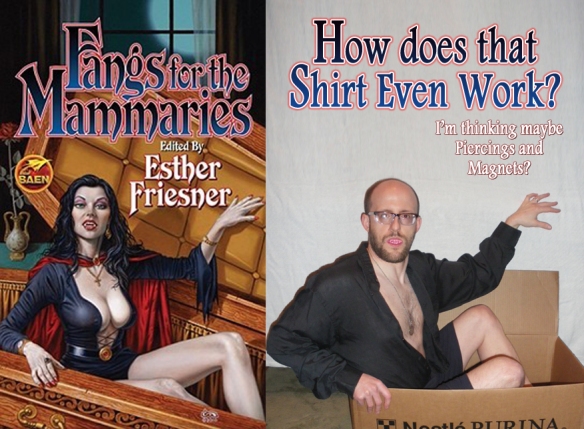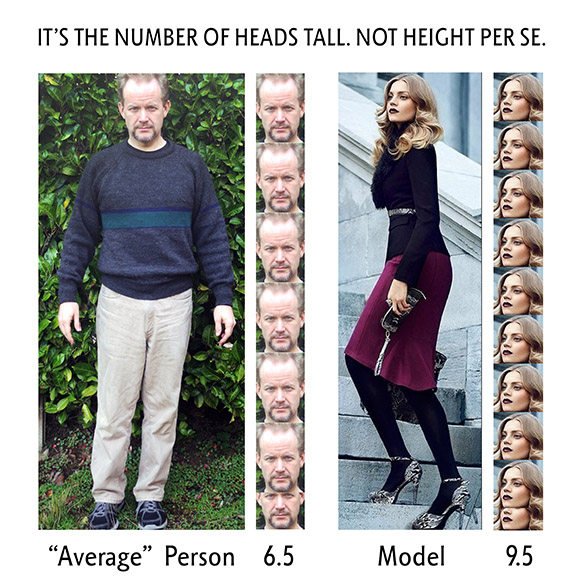Like many of my predecessors of the past century, I use models for all of my paintings with human figures and, in all but a few cases, I direct the photo shoots to get the exact reference I need to paint from. And most of you reading this will be aware of my Pin-Up Calendar and some of the good it’s done for charity. I suspect that’s why I was contacted last week by Jim Hines about my thoughts on the topic of sexism in SF/F. I have been following Jim Hines’s projects with interest, amusement, and a bit of an editorial chagrin. (Really Jim, you want some other kind of cover for the book Esther Friesner intended to call “Fangs for the Mammaries”?)
Jim Hines: “Do you believe sexism is an issue in SF/F art, and why or why not?”
Yes. Just as I believe racism, classism, and perhaps most dangerous of all, capitalism are.
Why is it an issue? Because people in the SF/F field are leaders, not followers. All of these isms are pieces of the human condition – the very area that our field claims to excel in exploring. All of them need to be dealt with. There are enough clever and sensitive people in our field and we need to be paying attention to and caring about these issues. Who else would think of having an award named after James Tiptree Jr.?
Jim Hines: “If so, where do you believe that problem comes from?”
It clearly comes from society. To paraphrase Madge in the old Palmolive commercials: “We’re soaking in it.”
It comes from fearful publishers and advertisers who know that “sex sells” in a country where “Prurient” and “Puritan” are all-too-often synonymous.
It comes from a culture that has become increasingly… disembodied, where the life of the mind is out of sync with the life of the body.
Sex is powerful, and sexism is a clear and present danger.
Jim Hines: “What’s the difference between painting a beautiful, sexy woman (or man) and objectifying them?”
This is perhaps a more difficult question than you intend. In my experience, the intent of the artist matters very little. Objectifying is, like beauty itself, in the eye of the beholder.
Robin Hobb, a participating author in my 2013 pin-up calendar, said it wonderfully:
“Lovely, scantily clad humans are sex objects only to people who objectify other human beings. And those people do that no matter how draped that person might be. In 1967, a Jesuit priest observed to our class that he really did not see the sense of a dress code, as an immodest girl cannot be made modest no matter how you drape her, and that a modest woman can be stripped of her garments but not her modesty. So there it is, for me. If you are looking at our calendar and seeing sex objects instead of fascinating characters, well, beauty is in the eye of the beholder. And so are sex objects.”
I cannot speak for other illustrators. But for myself, the goal is always to paint the person first. To paint women as persons in their own rights is key, as opposed to painting women for the male gaze. In the case of my calendar, I consider most all of the characters portrayed therein hero shots of a sort. And if they’re not raising swords or aiming guns, that may give you a notion of what I personally find heroic.
There are a few pin-ups in this year’s rank who have not been well-received. When I have read the comments thereon, I am struck to the extent to which I perceive slut shaming.
“Thanks for the assumption that a girl in a miniskirt must be slutty […] Why is my cover getting slut-shamed by someone who doesn’t know the girl in that picture, doesn’t know who she is or why that image is an accurate one? It’s like the art is awesome as long as it’s on a closet door, but if you’re asked to like it in public, it’s time to throw out a few micro-aggressions to keep people from thinking you’re ‘that kind’ of person.” – Seanan McGuire writing about Aly Fell‘s cover for her book Discount Armageddon.
As a cover artist, Aly Fell’s job, like mine, is to create an interesting or exciting visual narrative to promote the book, the product. I want to catch the eye, to engage the potential reader, and the more I can honestly reflect the author’s characters and intent, the better.
As a viewer, what narrative have you constructed in your head that tells you that a girl in a miniskirt is a slut or a surprised girl in lingerie is a bimbo?
Jim Hines: “What do you think we should do (if anything) to try to move past the modern-day trend of awkwardly posed, semi-clad heroines on book covers?”
Before I get into what I think is the real heart of your question, I want to speak on the importance of negative space and silhouette on the efficacy of a painting. While we see far fewer examples of pure silhouette than we did in the glory days of Leyendecker and Rockwell, the shapes of the figure and the shapes cut from the background by the figure are one of the most useful tools to an illustrator looking to create dynamism. (It should come as no surprise that the great Charles Dana Gibson was a child prodigy at cutting paper silhouettes years before he would probably look twice at a “Gibson Girl.”) Why are most models so tall and thin? It’s all about how dynamic a taller figure can be made to read. There’s a reason Jim Hines and I (playing the “average” person below) are not models:
There are many figures on book covers that are awkward at best and hideously malformed at worst (the tumblr site EscherGirls speaks to this at length). Sometimes that is the fault of an artist lacking skill or reaching too far for an interesting silhouette. Often however, the artists pull it off with nary a thought from the viewer as to the character being “wrong”. As I did my research about pin-ups I discovered something that surprised me: Pin-ups I’d seen for years were hiding something in plain site. Here’s a fun position you can assume in the comfort of your own home… if you happen to have between 3-5 extra vertebra that is:
 As to the scantily clad heroines, I dare say there is a time and place. This is a truth well recognized by today’s brilliant crop of art directors. Whether Irene Gallo at TOR or Lou Anders at Pyr, our field is being led by the best, and in this I believe that our field is now largely the exception to the rule. Sci-fi and fantasy create beautiful, often inspiring covers. We have a readership and creators that are aware and active in the discussion of sexism (and the additional isms.)
As to the scantily clad heroines, I dare say there is a time and place. This is a truth well recognized by today’s brilliant crop of art directors. Whether Irene Gallo at TOR or Lou Anders at Pyr, our field is being led by the best, and in this I believe that our field is now largely the exception to the rule. Sci-fi and fantasy create beautiful, often inspiring covers. We have a readership and creators that are aware and active in the discussion of sexism (and the additional isms.)
What can be done to make our covers better?
1. Understand that there is a problem; be conscious of the pitfalls of the combination commerce, text and images
2. Call atrocious work out when and wherever we see it, granting weight to all the parties involved (see Part 2, below)
3. Reward good work that shows our ideals in action
4. Continue this conversation, ideally in the context of all those other isms.
5. And painters? Don’t paint slavishly to the white male gaze, ok?
PART 2: EXAMPLES FROM COMICS AND GAMES
So, having spoken about SF/F covers, let’s look….ahem…briefly at a couple related fields that are nowhere near as circumspect.
I feel lucky that I don’t have to defend DC Comics’ (Warner Brothers’) decision to bring Power Girl’s costume back even as their arch nemesis Marvel (Disney) does the right thing by making Ms. Marvel into Captain Marvel at last:
 >Shudder< I have it on good authority that the brilliant editor at Lucasfilm would never allow this on her watch:
>Shudder< I have it on good authority that the brilliant editor at Lucasfilm would never allow this on her watch:
 This is the entire range of playable characters. Oy:
This is the entire range of playable characters. Oy:
 And this game “sizzle” art was brought to my attention by the splendid NK Jemisin:
And this game “sizzle” art was brought to my attention by the splendid NK Jemisin:
“It’s more than just the ridiculous butt-shots of the women in this image, complete with translucent boy shorts. It’s the contempt and humiliation in the way this is arranged — contempt on the part of Dante, a character who until lately has treated the women around him like people and not props; and humiliation on the part of the women. They’re groveling at his feet, clinging to him slavishly, even as he pantomimes shooting one of them in the face with his oh-so-phallic finger. Because women getting shot by their sexual partners is soooo hot and edgy, don’tcha know.” – NK Jemisin discussing the horror seen above.
The first time I saw this poster the only thing I could say was “Oh f&©# no.” This is a cover so deeply horrific that it can’t be fixed. Why even bother to comment that there are no women of color among the angels for example? Or ask why angels are wearing clingy Flash Gordon panties? Making any small changes to this horror show would be rearranging deck chairs on the Titanic. The fact that the painter seems quite adept at painting somehow makes the piece all the worse.
PART 3: OTHER, MORE FULSOME RESPONSES
The day after I sent my response to Jim, Arnie Fenner posted a typically thoughtful response to Jim’s projects on the Muddy Colors blog. He raised many excellent questions. Among them: are artists are being made the scapegoat for sexism, omitting any mention of the the industry, the art directors, and indeed the authors themselves? He received excellent responses, but my favorite is from a former ad man whose well-intentioned mistake led deep into the heart of how our isms are intertwined:
Gilead – March 13, 2013 at 8:02 PM
In my advertising days I once did an ad for a weight loss product. It had two cartoons showing the same guy as a before and after. On the left is a fat, stupid-looking guy busting the bathroom scale. In the middle is the product and on the right is the same guy looking robust, slender and somehow smarter. Are you picturing it? It’s kind of cute right? Kind of funny and gets the point across.
Now picture it again only this time, instead of a man, it’s a fat, stupid-looking woman. Or a black guy. Or an Asian. Whoa! All of a sudden that’s not funny. Now it’s like “What are trying to say here mister?”
I’d had this naïve idea that I could do some good by being all egalitarian. If the product was non gender-specific or race-specific I could mix it up and give everyone equal representation. It turned out that was a really bad idea and I got into all kinds of trouble. I learned that, in most people’s perception, a picture of a white male is a picture of a person – just a person. It could represent anyone: male or female, old or young, black or white. But a picture of a black person somehow represents blacks exclusively, and a picture of a woman somehow represents women exclusively.
If you draw a man you make a picture, but if you draw a woman you make a statement.
This is a cultural thing and it is probably fading away as we speak, but for now it still seems to be true. Which is why a picture of Conan can be accepted at face value as what the character looks like and what he wears, but a picture of a scantily dressed woman is seen not as a depiction of a character, but as a statement about women.
So I have no solutions I’m just trying to show a less obvious reason for the problem. When we look at a painting of a man and a woman we don’t see an every-man and an every-woman; we see a man and Women.
I am glad that so many people in our field care about these issues and I hope that this continues to be a deep and thoughtful discussion among artists, authors, publishers, and readers. Not just in the F/SF field, but in comics, games and everywhere else in the media landscape.





It’s funny that fat-shaming was okay, but anything perceived as racism or sexism wasn’t. My two cents: the ad for the weight loss product isn’t cute, either. Fat shaming is just as disgusting as sexism and racism and, well, any “ism.” It goes with an assumption that people being fat are entirely at fault, which is a lot like saying it’s my fault that my skin is lily white.
I agree with you. On the other hand I’m not sure how you advertise most of these bogus weight loss products without fat-shaming; I’m pretty sure there’s not a way to do them that’s not seriously problematic because the only people who will buy them have internalised fat-shaming to the point where they’re willing to buy medicinal products that aren’t proven to work that may very well be toxic.
There is a fundamental difference though, of the three, weight, race and gender, only weight can be altered through non-surgical means. That doesn’t mean that advertising shouldn’t grow up and be more sensitive regarding weight, but it also can’t be judged on the same standard.
Great post, Lee.
Love the alternate cover for “Fangs for the Mammories”.
I think because SF/F allows us to create new worlds and new social mores, we’re more likely to wrestle with concepts of sexism, racism and the other -isms. There was a time when a women writer couldn’t publish under her own name and certainly couldn’t have a female character if she wanted to sell. While S&S Fantasy or Epic fantasy still leans toward the male protagonist, the rise of urban fantasy has seen more female protagonists. A recent Tor release – Three Parts Dead by Max Gladstone – has a darkskinned female protagonist who is fully dressed on the cover.
Great comments overall. Thanks!
I really think that rather than the appalling sinkhole that F/SF has intermittently been, that we are really becoming leaders. I certainly hope so!
But there are always new dangers as publishers panic, circle their wagons, and all too often look for the same endlessly repeated stock-photo figures….
Eternal vigilance!
Sadly I have never thought deeply about the phrase Sex Object, always assumed that it was a sexy person, not strike that woman, lets be honest. However Sex and Object should really only be a phrase used for the battery powered type of object not a living breathing person. Really that phrase is just yuckky (to put it mildly). As a woman I like to be thought of as sexy but not an object, I am sure that men feel that same way too, but we have some way to go before we drag our perception of women up, hopefully not, drag the perception of men down (I hate man/husband bashing but that’s a rant for another day)
Jim Hines is a neo-Puritan fanatic crackpot. Or is Jim Hines another one of SFF’s increasingly common clever self promoters, who is using the anti-sexist schtick to get his name out there? I don’t ordinarily agree with Jerry Pournelle, but for me, on Hines, I’m convinced he nailed it with Erica Jong’s anecdote about aggressively seemingly ant- sexist men (Google it for yourself). I knew a guy like that back in the would be radical ‘ 70’s in my old college student co-op house. Even the most conservative, more traditional males were appalled and disgusted by how he used the indignant pro- feminist/disappointed in my fellow males routine to dazzle, manipulate, and bed naive left wing women who ordinarily would’t give the time of day to such a homely weasel as he was. – S.D.